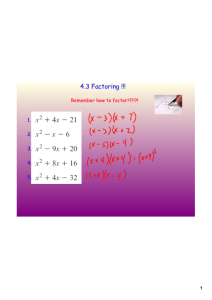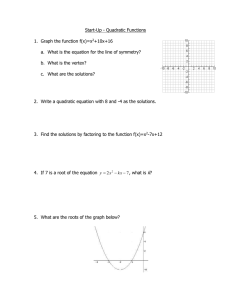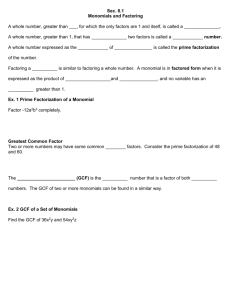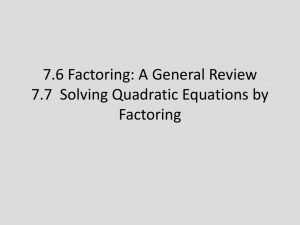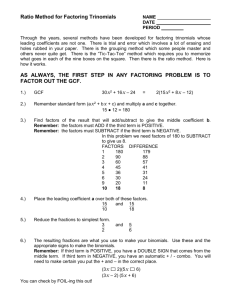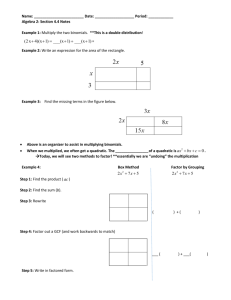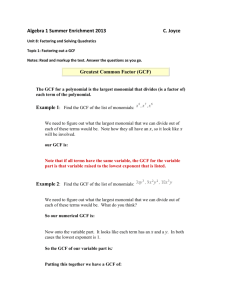4.1 – Common Factors in Polynomials Recall: Standard Form of
advertisement
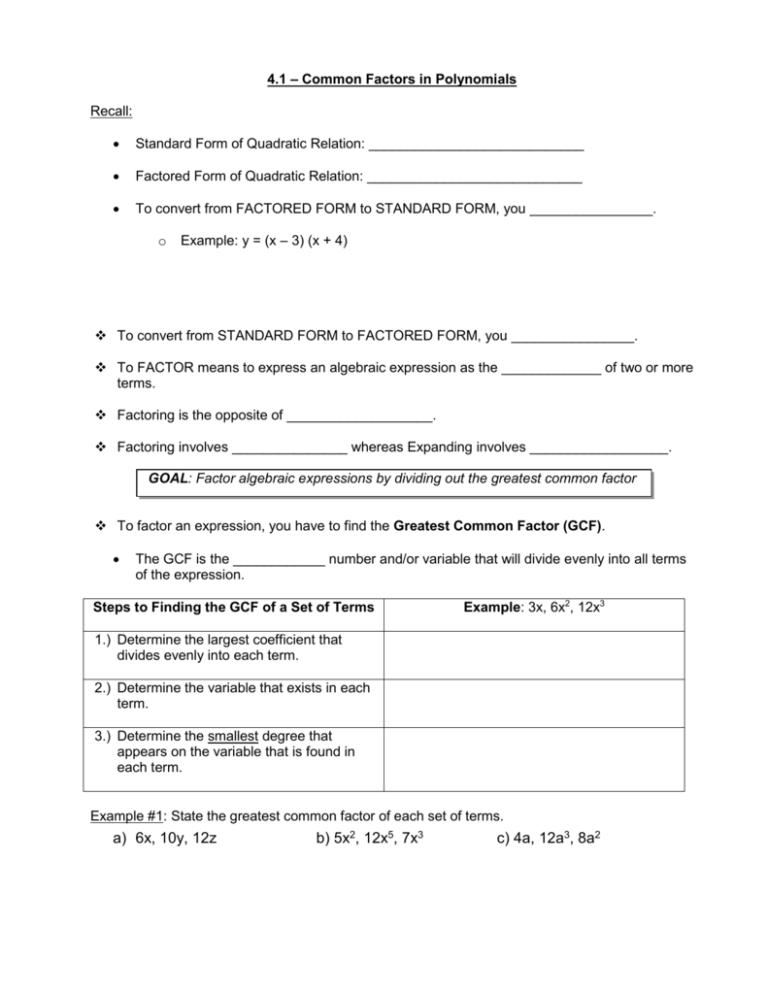
4.1 – Common Factors in Polynomials Recall: Standard Form of Quadratic Relation: ____________________________ Factored Form of Quadratic Relation: ____________________________ To convert from FACTORED FORM to STANDARD FORM, you ________________. o Example: y = (x – 3) (x + 4) To convert from STANDARD FORM to FACTORED FORM, you ________________. To FACTOR means to express an algebraic expression as the _____________ of two or more terms. Factoring is the opposite of ___________________. Factoring involves _______________ whereas Expanding involves __________________. GOAL: Factor algebraic expressions by dividing out the greatest common factor To factor an expression, you have to find the Greatest Common Factor (GCF). The GCF is the ____________ number and/or variable that will divide evenly into all terms of the expression. Steps to Finding the GCF of a Set of Terms Example: 3x, 6x2, 12x3 1.) Determine the largest coefficient that divides evenly into each term. 2.) Determine the variable that exists in each term. 3.) Determine the smallest degree that appears on the variable that is found in each term. Example #1: State the greatest common factor of each set of terms. a) 6x, 10y, 12z b) 5x2, 12x5, 7x3 c) 4a, 12a3, 8a2 Steps for Factoring an Expression Example: 4x2 + 6x4 – 12x3 1.) Find the _______ of the expression. 2.) Place the GCF ________________ of a bracket. 3.) Divide every term of the original equation by the GCF and place these new terms ________________ the bracket. Example #2: Factor each expression. a) 25a2 – 20a b) x4 – x6 + x2 c) 3y4 – 9y2 + 15y3 In some cases, there may be more than one common variable, which you will place in a bracket. You may need to “group” similar terms together before factoring. Steps for Factoring an Expression With More Than One Common Variable or Term 1.) Once you realize that there is no GCF for an expression, “group” the few terms in the expression that do have a common term or variable. 2.) For each group of terms that have a common factor, factor their GCF using the distributive property. 3.) Look for a common factor (of more than one term or variable) for both groupings. Example: ax – ay – 5x + 5y Example #3: Factor each expression. a) 2b(b+4) + 5(b+4) b) 5my +tm +5ny +tn When a quadratic relation is in standard form, you only know the direction of ______________ and the __________________. If you factor the quadratic relation in standard form, you can determine the ______________. Example #4: Given the quadratic relation y = – x2 – 8x, a.) Express the relation in factored form. b.) Determine the zeros. c.) Determine the vertex. d.) Sketch the graph. Example: Two parabolas are defined by y = x2 - 12x and y = - 5x2 + 50x. What is the distance between their maximum and minimum values (vertexes)? o Common factor Equation 1 o Determine the zeros of Equation 1 o Determine the max/min (vertex) of Equation 1 o Common factor Equation 2 o Determine the zeros of Equation 2 o Determine the max/min (vertex) of Equation 2 o Calculate the distance between the maximum and minimum Remember: Given the two points (x1, y1) and (x2, y2), the distance between these points is given by the formula: Homework: p. 203-204 #4ac, 5df, 6be, 7abf, 8bce, 9cef, 10 - 12, 14, 16

